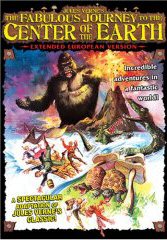
Based on the highly influential novel by early Science fiction grand-master Jules Verne, whose high-reaching imagination predicted visits to the moon, undersea submarines, and air travel long before science made his fancies a reality, JULES VERNE'S FABULOUS JOURNEY TO THE CENTER OF THE EARTH is a science fantasy high on adventure if low on technical polish (or logical sense). An ode to the pure sense of escapism in vintage pulp fiction, this film is a celebration of adventure, bordering on the fantastic in its examination of ancient, otherworldly creatures and dimensions. Directed by unjustly maligned genre specialist Juan Piquer Simon, who brought horror fans the psycho-sexual splatter gymnastics of Pieces, this special edition from newcomers Code Red comes hot on the heels of Don't Go In The Woods . . . Alone! If the quality of these two releases are any indication, the company looks to have a bright future. Released in 1978 under the title Where Time Began, this film looks better than ever in an anamorphic widescreen transfer designed to impress. Including additional footage from the European version, this grand adventure of lost races and prehistoric monsters on the rampage is a lively, colorful gift to the young at heart.
In a plot surprisingly satisfying in its deceptively simplistic structure, Journey to the Center of the Earth is a hybrid of various genres, emphasizing the heroic formula so very popular in the era of its author. More concerned with straight forward adventure and larger-than-life conflicts than with subtle characterizations, this is a story of bold ideas and dramatized senses, following in the old, grand sci-fi tradition. The racing plot features four very different people venturing into the mystery shrouded caves of a volcano in attempts to locate the center of the world. Moved by both personal curiosity and service to science, they discover instead a lost world of wonders and nightmares -- some of which are huge prehistoric monsters -- others that are disconcertingly familiar. An FX of still imaginative FX and escapism, this pot-boiler mixes science with technical verve. While characters are realistically defined, they are more generally 'types' than individuals -- heroes, scientists, and other stock examples of archetype. Of course the major characters, and the greatest reason to recommend the film, are the alien pre-history landscapes and the monsters that undoubtedly filled matinees with shrieks of fright and laughter.
The Fabulous Journey to the Center of the Earth marries pulp fantasy with science-fiction, blurring the dividing lines between genre and fan sensibilities, as well as between science fiction and fact. Style and convention are played one against the other, with audience expectations constantly thwarted by the director's offbeat style. The varying quality of the effects and story logic make for a roller coaster of improbable action set pieces and explosive action. Not a complete success, hampered by somewhat crass idiocy and a lack of inspiration in both aesthetic objectives and production values, Simon's obvious -- even childlike -- enthusiasm, and an obvious ability to stretch his dollar value-- injects charm and simple wonder into even the more ludicrous moments -- something that can't be often said in this day of multi-billion dollar turds that lack this film's essential showmanship. This journey to a mythical land beneath the earth is also an epic journey into the summits of our species' very sense of wonder. Paradoxically, the story itself, and this film adaptation, both celebrates and warns against the driving curiosity that makes men explore the outer regions of space and time. A surprising amount of suggested sub-text can be discerned alongside the more obvious hurricanes of monster action. Such themes as scientific progressivism, Darwin's evolutionary theories, the 'nobel' savage, and Western expansion -- the urge to go forever onward and conquer new lands -- lend spice to the otherwise slam-bam, knock-down hysterics of the narrative. The sequence of events, and their timing/pacing lend momentum and suspense, with rarely a dull moment. In this the film is similar to the serials of old, with various scenes sporting 'cliff-hanger' moments. If the budgetary restraints and technical flaws hamper the raw adventure that the story itself so flawlessly suggests, than the momentum itself quickly makes one forget what doesn't work, keeping us hooked on simply enjoying the magic show unfolding in front of us. Performances from such legendary genre thespians as Jack Taylor and Frank Brana make the absurd believable. In short, this is a unique addition to the once hugely popular 'lost world' and 'lost race' fantasies of such writers as H. Rider Haggard and A. Merritt. Simon's movie is a nostalgic return to the days when movies were -- gasp! -- simply fun to watch, and its rescue from Code Red an admirable achievement indeed.
Visual quality for this transfer is quite good. The widescreen 1.78:1 print, while showing some small amounts of grain and blurred imagery, is for the most part clean and vibrant. The colors are bright and rich. Audio in Dolby Digital is largely clean and distortion free -- impressive for such an obscure film. And while extras are not anywhere near the quality or quantity we've come to expect from Media Blasters/Code Red, they are engaging. A theatrical trailer is included, as is a brief stills gallery and fun theatrical trailer. Most important of all, of course, is the colorful, visually surreal motion picture itself, lovingly saved from the mounting dust of some studio's junk pile by a company quick becoming a fan favorite.
Review by William P. Simmons
| Released by Code Red |
| Region 1 - NTSC |
| Not Rated |
| Extras : |
| see main review |